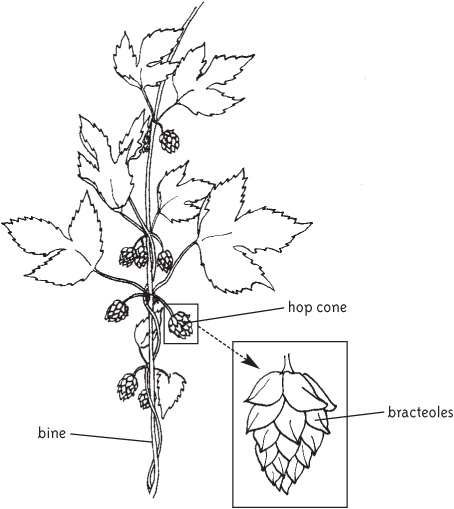The Homebrewers Garden
How to easily grow, prepare and use your own Hops Brewing Herbs Malts
Joe Fisher and Dennis Fisher

The mission of Storey Publishing is to serve our customers by publishing practical information that encourages personal independence in harmony with the environment.
Edited by Brad Ring
Cover design by Rob Johnson, Rob Johnson Design
Cover photographs StockFood: Foster (center),
Martina Meuth (top left), Zabert Sandmann (top)
Text design and production by Mark Tomasi
Line drawings by Sarah Brill, except for those by Cathy Baker (pages 26-28);
Beverly Duncan (pages 67, 69, 72, 85, 88, and 89);
Judy Eliason (page 99);
Brigita Fuhrmann (pages 53, 62, 73, 80, 81, 84, 92, 95, 98, and 104);
Charles Joslin (page 96); and Mallory Lake (pages 76, 91, 94, and 102)
Indexed by Nan Badgett, Word ability
1998 by Joe Fisher and Dennis Fisher
All rights reserved. No part of this book may be reproduced without written permission from the publisher, except by a reviewer who may quote brief passages or reproduce illustrations in a review with appropriate credits; nor may any part of this book be reproduced, stored in a retrieval system, or transmitted in any form or by any means electronic, mechanical, photocopying, recording, or other without written permission from the publisher.
The information in this book is true and complete to the best of our knowledge. All recommendations are made without guarantee on the part of the author or Storey Publishing. The author and publisher disclaim any liability in connection with the use of this information. For additional information please contact Storey Publishing, 210 MASS MoCA Way, North Adams, MA 01247.
Storey books are available for special premium and promotional uses and for customized editions. For further information, please call 1-800-793-9396.
Printed in the United States by Versa Press
20 19 18 17 16 15 14 13 12 11 10 9
Library of Congress Cataloging-in-Publication Data
Fisher, Joe, 1966
The homebrewer's garden : how to easily grow, prepare, and use your
own hops, brewing herbs, malts / Joe Fisher and Dennis Fisher.
p. cm.
Includes bibliographical references (p. - ) and index.
ISBN 978-1-58017-010-9 (pbk. : alk. paper)
1. BrewingAmateur's manuals. 2. Hops. 3. Herbs. 4. Malt.
I. Fisher, Dennis, 1963 . II. Title.
TP570.F543 1998
641.8'73dc21
98-19169
CIP
Table of Contents
Dedication
To Poppa Donald and Gram Ruth
Acknowledgements
Many people helped us in the research of this book. We would especially like to thank Dena Nishek, formerly of Zymurgy magazine; Walter K. Wornick of the American Heather Society; Susan Yusishen of Performance Seeds Ltd.; Gordon Gowlett of Maris Otter; Murray McLelland of Alberta Agriculture; Professor William TeBrake; John Bunker of Fedco Seeds; Brad and Caitlin Hunter of Appleton Creamery; Tina Roberts and Steve Peary; Rani Cross of Skyscraper Hill Organic Gardens; Sumner and Paula Roberts of Meadowsweet Farm; Matt Williams; Dana and Mark Llewellyn of Apple Hill Farms; Ben Gleason, Scott Nelson, and Don Wagoner; Pamela Lappies; our parents, and Sue.
1
Homegrown Hops
Because it is easy to grow, so they should be in every garden; every landowner should devote a small area to them sufficiently large to allow in a good hop year enough hops to be grown for his own house brewery.
Johannes Gottfried Hahn, Die Hausbrauerei, 1804
THIS advice still sounds good today. Hops are a versatile crop that can be grown for both ornamental and practical purposes. They are attractive plants that make great arbors, wreaths, arrangements and of course beer. Every homebrewer who owns a piece of land should try his or her hand at growing a few hop vines.
When you grow your own hops, you can pick them at their absolute peak of readiness. As soon as hops are picked, they start to lose the essential oils needed for good flavor and aroma. The best way to know that your hops havent been sitting on a shelf for a year is to grow your own. Commercial whole hops, the least processed form available, have been cut down, run through a picking machine, dried, baled, shipped, repackaged, and shipped again before reaching your homebrew store. Inevitably, some of the hops bitter resins and essential oils are lost during processing. Your own hops will never have to run that gauntlet, making them fresher, more aromatic, and better for brewing than any you could buy. Homegrown hops have a fresh earthiness that adds a delicious immediacy to the beer drinking experience. The aroma alone will be enough to convert you, to say nothing of the flavor.

You can also save money growing your own hops. Once the initial investment of a few dollars per plant is made and youve bought your trellis materials, there will be few other expenses beyond the time you spend tending the plants. For an average batch of beer, you can spend three dollars just for the hops in a homebrew store. This translates into a fair amount of money if you brew frequently. You can dramatically reduce this bill and even eliminate it altogether, if youre willing to go to the trouble of growing all of your own bittering and aroma hops.
The best reason of all to grow hops may be a spiritual one. A fine, lush trellis of the green, prickly vines, heavy with hop flowers, says as well as anything else that you are a serious homebrewer. And believe us, your guests will be extremely impressed when you tell them that you grew the hops in the beer theyre drinking.
Humulus lupulus: The Friendly Hop
Cultivating hops is easy; all they really need is reasonably fertile soil, plenty of sunlight and moisture, and something to climb on. Hops are so vigorous, in fact, that their tendency to run wild in cultivated fields is commemorated in the second part of their botanical name: Lupulus means wolflike.
The cone blossoms of the female vine are the part that homebrewers are concerned about. They contain lupulin, a yellowish powder that contains the bitter resins and essential oils that give beer its flavor and aroma.
Hop Facts |
Anatomy There are both male and female hop plants, but for beer making only the female is important. Females produce scaly cones about 1 inch (2.5 cm) long that are loaded with lupulin, a yellow powder that contains the bitter resins and essential oils that give beer its flavor. The cones hang in clusters. The petals on the cone are called bracteoles and hide the lupulin glands. The coiling green vines are also called bines the botanical term for twining vines. The vines are covered with a thick growth of large, spiky leaves shaped something like cucumber leaves. The vines grow from thick rhizomes, which are underground stems that look like fat roots. The entire root-and-rhizome structure is called a crown. New hop plants are usually grown from rhizomes divided off other hop crowns. |
Properties The hop plant (botanical name: Humulus lupulus) is a vining perennial, meaning its vines will grow year after year from the same roots if cared for properly. The plant has a very vigorous growth habit, sending up long, spiny shoots that can reach up to 30 feet (9 m) in height. The plant can tolerate poor soil but grows best in rich ground and is hardy to Zone 3. It likes moisture and plenty of sun. The rhizomes spread underground almost as fast as the vines do aboveground. Vines need regular pruning each year, and even the rhizomes benefit from root pruning every three years. Hop vines require a strong, permanent structure to support them, such as a trellis or pergola. |










